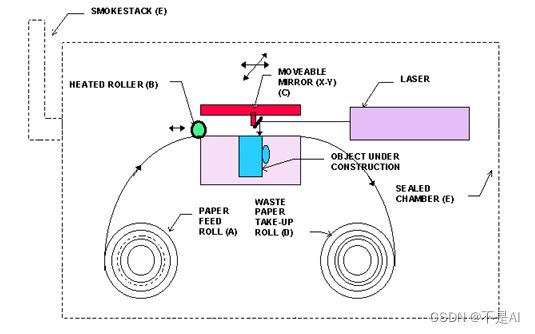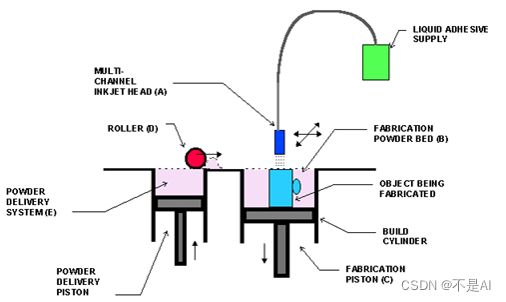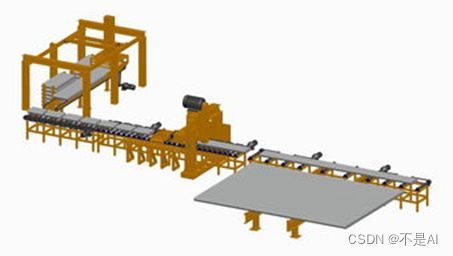【北京航空航天大学】【本科生英文课程】【先进制造技术概论(Introduction to Advanced Manufacturing Technology)】【课程报告】
IMMT Final Report on Additive and Subtractive Manufacturing
Abstract
In the past half-century, traditional manufacturing processes such as mechanical processing and injection molding with high quality, low cost, and high speed have been regarded as the industrial standard for mass production. At the time, additive manufacturing (also known as 3D printing) was only useful in the context of rapid prototyping and small-batch production operations.
Nowadays, with the continuous shortening of product life cycle and the ever-increasing demand for personalized products, companies are beginning to face great pressure on the time to market and cost of products, and the efficiency of traditional manufacturing technology is no longer adequate. However, in recent years, additive manufacturing technology has made rapid progress in the field of equipment and materials. It is not surprising that the rapidly taking off additive manufacturing technology has surpassed the manufacturing industry and entered the medical and other markets. From nanoscale metal structures and food to human tissues and organs, buildings, and even the entire city may be printed in the future-all kinds of dazzling things can be 3D printed, showing endless possibilities.
This article mainly introduces the definition of additive manufacturing and subtractive manufacturing, related technologies, industry applications, and future development trends, aiming to have a detailed and in-depth understanding of these two technology groups.
1. Introduction
1.1 Definition of Additive Manufacturing and Subtractive Manufacturing
Additive manufacturing technology refers to a scientific and technological system that directly manufactures parts driven by 3d data of parts based on discrete-stacking principle. Based on different classification principles and ways of understanding, additive manufacturing technology is also called rapid prototyping, rapid manufacturing, 3D printing and so on. [1]
Subtractive Manufacturing is conceptually relative to “additive manufacturing”. It clamps and fixes the raw material on the equipment, and cuts the excess material layer on the blank or workpiece into chips by cutting tools, so that the workpiece can obtain the specified geometric shape, size and surface quality. [2]
1.2 Classifications
Academician Guan Qiao proposed the concepts of “broad sense” and “narrow sense” additive manufacturing. The “narrow sense” additive manufacturing refers to the technical system of combining different energy sources with CAD/CAM technology and layering and accumulating materials; and “broad sense” Additive manufacturing is a large-scale technology group with the basic feature of material accumulation and the goal of directly manufacturing parts. If classified according to the type and method of processing materials, it can be divided into metal forming, non-metal forming, and biological material forming.
Subtractive Manufacturing can be divided into two categories: cutting methods with fixed blade shape and number of blades include turning, drilling, boring, milling, planing, broaching and sawing; cutting methods with unfixed blade shape and number of blades using abrasive tools or abrasives include grinding, honing, polishing, etc.
2. Related Technologies
2.1 Related Technologies for Additive Manufacturing
2.1.1 Stereo Lithography Apparatus (SLA)
Stereo lithography technology uses a computer to control the laser beam, and through the design data provided by the CAD system, the beam is used to solidify the liquid photosensitive resin layer by layer. It combines the horizontal movement of the laser beam and the vertical movement of the platform to create three-dimensional objects. [3]
Figure 1. Stereo Lithography Apparatus (SLA)
2.1.2 Selective Laser Sintering (SLS)
Selective Laser Sintering uses infrared lasers as energy sources, and most of the modeling materials used are powder materials. During processing, the powder is first preheated to a temperature slightly lower than its melting point, and then the powder is flattened under the action of a flattening stick; the laser beam is selectively sintered according to the information of the layered cross section under computer control, and one layer is completed. Then, the next layer is sintered, and after all the sintering is completed, the excess powder is removed, and a sintered part can be obtained. The mature process materials are wax powder and plastic powder, and the process of sintering with metal powder or ceramic powder is still under study.
Figure 2. Selective Laser Sintering (SLS) [4]
2.1.3 Fused Deposition Modeling (FDM)
Fused Deposition Modeling is a process developed by American scholar Dr. Scott Crump in 1988. It is a method that does not use laser processing. Its principle: the nozzle moves in x-y linkage and z-direction under the control of the computer. The wire is heated in the nozzle to a temperature slightly higher than its melting point and squeezed out through the nozzle with a fine nozzle. [5]
Figure 3. Fused Deposition Modeling (FDM)
2.1.4 Laminated Object Manufacturing (LOM)
Laminated Object Manufacturing (LOM) is formed by bonding boxes or paper with glue on the back. The paper roll coated with hot melt glue on one side is sleeved on the paper roll, and is wound on the take-up roll across the supporting roll. The same server motor drives the take-up roller to rotate, so that the paper roll moves a certain distance. The workbench rises to contact with the paper surface, and the hot pressing roller rolls along the paper surface from right to left to heat the hot melt adhesive on the back of the paper and make this layer of paper adhere to the previous layer of paper on the substrate. The laser beam emitted by the CO2 laser tracks the two-dimensional cross-sectional profile data of the part for cutting, and cuts the waste paper residue outside the profile into small square grids to facilitate the peeling after the forming process is completed. Each time a section is cut, the workbench and the cut contour layer are automatically lowered to a certain height, and the next working cycle is repeated until a three-dimensional paper prototype part is formed with layered cross-sections. Then peel off the small squares of waste paper to get a “paper-like product” that looks like hardwood or plastic. [6]
Figure 4. Laminated Object Manufacturing (LOM)
2.1.5 3-D Printing
3-D Printing (also known as additive manufacturing, layered manufacturing) is a technology that builds objects based on digital model files and uses bondable materials such as powdered metal or plastic to print layer by layer. This technology was proposed by the United States in the mid-1980s.
3-D Printing is often used to manufacture models in the fields of mold manufacturing, industrial design, etc., and then gradually used in the direct manufacturing of some products, which has a profound impact on the traditional process flow, production line, factory model, and industrial chain combination. [7]
Figure 5. 3-D Printing
2.2 Related Technologies for Subtractive Manufacturing
2.2.1 Turning
Turning is a part of mechanical processing, also known as lathe processing. Lathe processing mainly uses a turning tool to turn a rotating workpiece. Drills, reamers, taps, dies and knurling tools can also be used on the lathe for corresponding processing. Lathes are mainly used to process shafts, discs, sleeves and other workpieces with rotating surfaces. They are the most widely used type of machine tool processing in machinery manufacturing and repair factories. [8]
Figure 6. Turning
2.2.2 Drilling
Drilling refers to the processing of holes in the workpiece with a drill or a reaming drill. Drilling workplaces include bench drilling machines, deep hole drilling machines, vertical drilling machines, radial drilling machines, center hole drilling machines and so on. The tools used for drilling include twist drills, group drills, reamers, taps, cylindrical countersinks, face countersinks, tapered countersinks, and so on.
Economic accuracy: IT13-IT11
Surface roughness: Ra value 50-12.5 microns
Advantages: ①The metal removal rate is relatively high. ②Twist drills are not as easy to bend as single-edged tools
Disadvantages: ①Draining problem: Difficulty in drilling and chip removal. ② Cooling problem: difficult to cool. ③Orientation and centering problem: The drill bit has poor rigidity and is easy to conceal deviation. ④Surface roughness problem: cutting, extruding, rubbing the machined surface, the surface roughness is relatively large. [9]
Figure 7. Drilling
2.2.3 Boring
Boring refers to the use of a rotating single-edged boring tool to enlarge the prefabricated hole on the workpiece to a certain size, so that it can achieve the required precision and surface roughness. Boring is generally carried out on boring machines, machining centers and modular machine tools, and is mainly used to process cylindrical holes, threaded holes, grooves and end faces on workpieces such as boxes, brackets and bases. The boring precision of steel materials can generally reach IT9~7, and the surface roughness is Ra2.5~0.16 microns. [10]
Figure 8. Boring
2.2.4 Milling
Milling refers to the use of rotating multi-edge tools to cut workpieces, and is a high-precision machining method. When working, the tool rotates (for the main movement), the workpiece moves (for the feed movement), and the workpiece can also be fixed, but the rotating tool must also move (to complete the main movement and the feed movement at the same time). The machine tools used for milling are horizontal milling machines or vertical milling machines, as well as large portal milling machines. These machine tools can be ordinary machine tools or CNC machine tools.
Figure 9. Milling
2.2.5 Sawing
Sawing is a cutting process in which a workpiece or material is divided by a hand saw. The work scope of sawing includes: dividing various materials or semi-finished products, sawing off excess parts on the workpiece, and sawing grooves on the workpiece. Sawing can be divided into bow sawing, circular sawing, band sawing and grinding wheel sawing according to the type of tool used. The sawing equipment generally uses a carbide circular saw blade as the sawing tool, which greatly improves the wear resistance of the saw blade; the equipment adopts pneumatic transmission to realize the clamping and work advancement of the profile; the cutting surface is smooth and the cutting quality is high. The accuracy of various sawing methods is not high, except for narrow band sawing, it is generally used to cut various bars, pipes and other profiles in the material preparation workshop. [12]
Figure 10. Sawing
2.2.6 Grinding
Grinding is a unit operation that converts solid materials into smaller particles. In order to grind different materials, humans use various grinders, including manual mortars, mills driven by animals, wind or water, and electric mills driven by electricity. Grinding is also a fine manufacturing method. Using abrasive particles coated or press-embedded on the grinding tool, the processing surface is finished by the relative movement of the grinding tool and the workpiece under a certain pressure. Grinding methods can generally be divided into three types: wet grinding, dry grinding and semi-dry grinding. It is an important condition to improve the quality of the grinding to properly handle the movement trajectory of the grinding. Consumables used with grinding equipment mainly include grinding wheels, belts and other products. The abrasive belt uses high-voltage electrostatic field force to plant fine abrasive grains on a high-strength film, so that the abrasive grains can be oriented and evenly distributed, which can provide higher grinding efficiency and bright and detailed polishing effects. Abrasive particles include alumina, silicon carbide, and so on, suitable for grinding and polishing materials with different hardness. [13]
2.2.7 Polishing
Polishing refers to the use of mechanical, chemical or electrochemical effects to reduce the surface roughness of the workpiece to obtain a bright and smooth surface. The polishing technology is mainly divided into: mechanical polishing, chemical polishing, electrolytic polishing, ultrasonic polishing, fluid polishing, magnetic abrasive polishing and so on. Polishing cannot improve the dimensional accuracy or geometric accuracy of the workpiece, but aims to obtain a smooth surface or mirror gloss. Sometimes it is also used to eliminate the gloss (matting). The polishing wheel is usually used as a polishing tool. [14]
Figure 12. Polishing
3. Applications of AM and SM
3.1 Applications of Additive Manufacturing
3.1.1 Applications in Manufacturing
For different component designs, additive manufacturing can be printed directly and quickly to meet different levels of demand and save time and cost. In addition, additive manufacturing helps to improve the production efficiency of the assembly line. Because additive manufacturing is fast and low-cost, everything can be done directly in-house. [15]
3.1.2 Applications in Advertising Sign Industry
Merchants can use additive manufacturing to make decorations for outdoor or indoor decoration, so that the products are consistent with the store decoration style. Merchants use additive manufacturing to create 3D models with image characteristics to promote and guide consumers. Labor saving, low cost, many changes, strong sense of science and technology. Additive manufacturing can solve the more difficult problems encountered in custom advertising signs, and even the traditional methods can’t solve the problems at all.
3.1.3 Applications in Architecture
Urban planning no longer displays the urban planning blueprint in a flat way, and allows the urban planning to be displayed in a three-dimensional form within a few hours, so that all visionary thoughts and concepts can be truly visible. Real estate companies no longer have to spend hundreds of thousands to find a company that specializes in making sand tables to display their own properties that are about to open. Additive manufacturing technology directly prints real estate renderings, eliminating the problems such as complicated communication process, expensive production cost and long production cycle.
3.1.4 Applications in Biomedical Industry
When human bones are accidentally injured, additive manufacturing technology can be used to print materials compatible with the human body to achieve zero rejection and differentiated manufacturing. Some time ago, 3-D printed heart, lungs, and skin were all studied by scientists, and it may solve the problem of insufficient donors in organ transplantation in the future. 3-D printed equipment, 3-D printed surgical auxiliary models, etc. are all 3-D printed medical equipment, which can better help doctors complete risky operations.
3.2 Applications of Subtractive Manufacturing
Subtractive manufacturing is suitable for parts with simple structure and mass production. Subtractive manufacturing can be used to verify appearance or functional testing of R&D design, that is, prototype processing. Subtractive manufacturing is suitable for industries that require accurate and durable models, such as automobiles, household appliances, telecommunications, and digital markets. [16]
4. Future Trends of AM and SM
4.1 Future Trends of Additive Manufacturing
4.1.1 Distributed Manufacturing
Distributed manufacturing is changing the way companies integrate additive manufacturing into their digital strategies. Through decentralized production and distributed manufacturing, finished products can be closer to consumers. And additive manufacturing technology can provide manufacturers with a more complete and continuous digital thread running through the physical supply chain, and efficient management of the entire process from the design concept to the life cycle of the product. Manufacturers only need to send a document to assign production tasks to any location equipped with a digital manufacturing system, which makes the supply chain arrangement more coordinated, transparent and efficient.
4.1.2 Integration with the Internet
We can clearly see how the combination of additive manufacturing and the Internet has had a huge impact on production methods. The cloud sharing of data and information will enable everyone to participate in the design. The popularity of 3D printers will enable everyone to participate in production. The cloud 3D printing platform (such as SimpNeed—3D printing,) will provide a platform for exchanges between people, people and information, and information and information.
4.2 Future Trends of Subtractive Manufacturing
4.2.1 Automation
Through automated production lines, CNC machine tools, robots, 3D printing and other technologies, the human-machine collaboration in the production process is realized, and the whole process control and optimization from the production line to the factory is realized. In the future, it will develop into a model of human-machine collaboration and unmanned factory.
4.2.2 Informatization
Through the information system, industrial software, etc., the data can be interconnected and applied to realize the transparency and visualization of the production process. It will develop into a cloud platform model in the future.
4.2.3 Networked
Through the Internet of Things (IoT), cloud platform, 5G and other technologies, the equipment, systems, and data of the core manufacturing links are interconnected to realize the collaboration of manufacturing enterprises across businesses, workshops, factories, and internal and external customers. It will develop into a model of ecosystem integration in the future.
4.2.4 Intelligence
Through industrial Internet, artificial intelligence, 3D simulation, digital twin and other technologies, the coordination and synchronization of equipment and software systems are realized. In the future, it will develop into an intelligent decision-making, autonomous execution and optimization model.
5. Conclusion
Today in the 21st century, human society has entered a new era of Industry 4.0. Additive manufacturing, represented by 3D printing, has emerged in the manufacturing industry. It can be mass-produced, supports a variety of new materials, and has many advantages that traditional subtractive manufacturing does not possess. However, despite the rapid development of additive manufacturing, it still cannot completely replace the position of traditional subtractive manufacturing. Many new technologies still face challenges such as immaturity, high cost, and slow molding. Nevertheless, we are confident enough to believe that additive manufacturing has a bright future, and that the future belongs to additive manufacturing.
References
[1]. 增材制造 - 搜狗百科 (sogou.com)
[2]. 减材制造 (xincailiao.com)
[3]. 立体光刻技术 - 搜狗百科 (sogou.com)
[4]. 选择性激光烧结 - 搜狗百科 (sogou.com)
[5]. 熔融沉积成型 - 搜狗百科 (sogou.com)
[6]. 叠层实体制造法 - 搜狗百科 (sogou.com)
[7]. 3D打印 - 搜狗百科 (sogou.com)
[8]. 车削 - 搜狗百科 (sogou.com)
[9]. 涨知识系列︱钻削?镗削?傻傻分不清! - 知乎 (zhihu.com)
[10]. 镗削 - 搜狗百科 (sogou.com)
[11]. 铣削 - 搜狗百科 (sogou.com)
[12]. 锯切 - 搜狗百科 (sogou.com)
[13]. 研磨 - 搜狗百科 (sogou.com)
[14]. 抛光 - 搜狗百科 (sogou.com)
[15]. 3D打印的10大行业真实应用 - 百度文库 (baidu.com)
[16]. 减材制造 - 机械加工CNC——睿现科技 (ach-wisdom.com)











